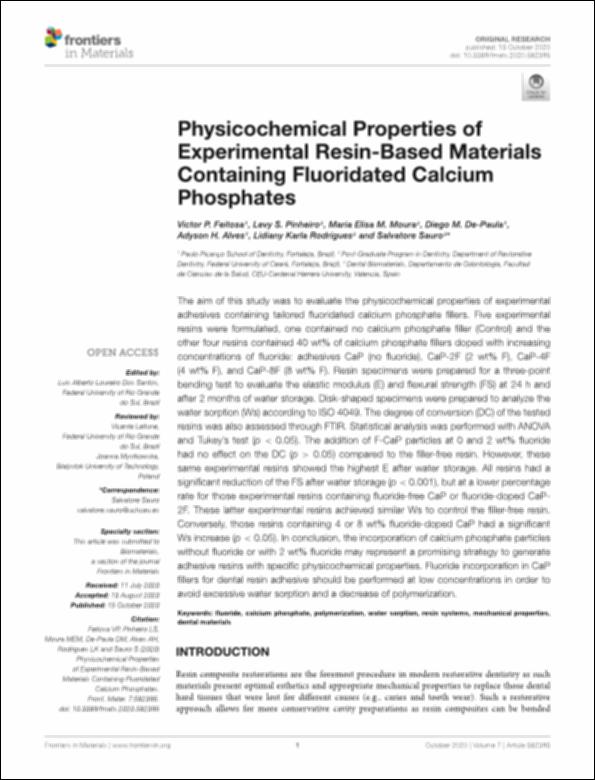Por favor, use este identificador para citar o enlazar este ítem:
http://hdl.handle.net/10637/12560Physicochemical properties of experimental resin-based materials containing fluoridated calcium phosphates
| Título : | Physicochemical properties of experimental resin-based materials containing fluoridated calcium phosphates |
| Autor : | Feitosa, Victor Pinheiro Pinheiro, Levy S. Martins Moura, Maria Elisa Martins de Paula, Diego Alves, Adyson H. Rodrigues, Lidany Karla Sauro, Salvatore. |
| Materias: | Odontología restauradora.; Materiales dentales.; Dentistry, Operative.; Dental adhesives - Properties.; Adhesivos dentales - Propiedades.; Gums and resins in Dentistry.; Gomas y resinas - Aplicaciones en Odontología.; Dental materials. |
| Editorial : | Frontiers Media. |
| Citación : | Feitosa, V.P., Pinheiro, L.S., Moura, M.E.M., De-Paula, D.M., Alves, A.H., Rodrigues, L.K. et al. (2020). Physicochemical properties of experimental resin-based materials containing fluoridated calcium phosphates. Frontiers in Materials, vol. 7, art. 582395 (15 oct.). DOI: https://doi.org/10.3389/fmats.2020.582395 |
| Resumen : | The aim of this study was to evaluate the physicochemical properties of experimental adhesives containing tailored fluoridated calcium phosphate fillers. Five experimental resins were formulated, one contained no calcium phosphate filler (Control) and the other four resins contained 40 wt% of calcium phosphate fillers doped with increasing concentrations of fluoride: adhesives CaP (no fluoride), CaP-2F (2 wt% F), CaP-4F (4 wt% F), and CaP-8F (8 wt% F). Resin specimens were prepared for a three-point bending test to evaluate the elastic modulus (E) and flexural strength (FS) at 24 h and after 2 months of water storage. Disk-shaped specimens were prepared to analyze the water sorption (Ws) according to ISO 4049. The degree of conversion (DC) of the tested resins was also assessed through FTIR. Statistical analysis was performed with ANOVA and Tukey’s test (p < 0.05). The addition of F-CaP particles at 0 and 2 wt% fluoride had no effect on the DC (p > 0.05) compared to the filler-free resin. However, these same experimental resins showed the highest E after water storage. All resins had a significant reduction of the FS after water storage (p < 0.001), but at a lower percentage rate for those experimental resins containing fluoride-free CaP or fluoride-doped CaP- 2F. These latter experimental resins achieved similar Ws to control the filler-free resin. Conversely, those resins containing 4 or 8 wt% fluoride-doped CaP had a significant Ws increase (p < 0.05). In conclusion, the incorporation of calcium phosphate particles without fluoride or with 2 wt% fluoride may represent a promising strategy to generate adhesive resins with specific physicochemical properties. Fluoride incorporation in CaP fillers for dental resin adhesive should be performed at low concentrations in order to avoid excessive water sorption and a decrease of polymerization. |
| Descripción : | Este artículo se encuentra disponible en la siguiente URL: https://www.frontiersin.org/articles/10.3389/fmats.2020.582395/full#h7 |
| URI : | http://hdl.handle.net/10637/12560 |
| Derechos: | http://creativecommons.org/licenses/by/4.0/deed.es |
| ISSN : | 2296-8016 (Electrónico). |
| Fecha de publicación : | 15-oct-2020 |
| Centro : | Universidad Cardenal Herrera-CEU |
| Aparece en las colecciones: | Dpto. Odontología |
Los ítems de DSpace están protegidos por copyright, con todos los derechos reservados, a menos que se indique lo contrario.


